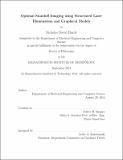Optimal standoff imaging using structured laser illumination and graphical models
Author(s)
Hardy, Nicholas D. (Nicholas David)
DownloadFull printable version (4.168Mb)
Other Contributors
Massachusetts Institute of Technology. Department of Electrical Engineering and Computer Science.
Advisor
Jeffrey H. Shapiro.
Terms of use
Metadata
Show full item recordAbstract
Structured illumination can be used to form images without using a lens or a detector array. A series of spatially-structured laser pulses is cast on the scene of interest, and a single-detector power measurement is made on the light each pulse returns from the scene. There has been significant interest in the "ghost imaging" configuration, in which the spatial patterns are randomly generated-e.g., by driving the pixels of a spatial light modulator with independent, identically-distributed pseudorandom inputs-and the sequence of measurements is correlated with reference versions of those patterns to image the scene. This naive reconstruction, however, is far from optimal for standoff imaging, for which rough-surfaced objects create laser speckle in the measurements. We develop a graphical model that encompasses the probabilistic relationships in structured-illumination standoff imaging along with an approximate message-passing algorithm for belief propagation to perform optimal scene reconstruction. This approach lets us accurately model the statistics of speckled images, photon detection, and atmospheric turbulence, as well as incorporate intelligent priors for the scene that capture the inherent structure of real-world objects. The result is state-of-the-art scene reconstructions.
Description
Thesis: Ph. D., Massachusetts Institute of Technology, Department of Electrical Engineering and Computer Science, 2014. This electronic version was submitted by the student author. The certified thesis is available in the Institute Archives and Special Collections. Cataloged from student-submitted PDF version of thesis. Includes bibliographical references (pages 241-246).
Date issued
2014Department
Massachusetts Institute of Technology. Department of Electrical Engineering and Computer SciencePublisher
Massachusetts Institute of Technology
Keywords
Electrical Engineering and Computer Science.